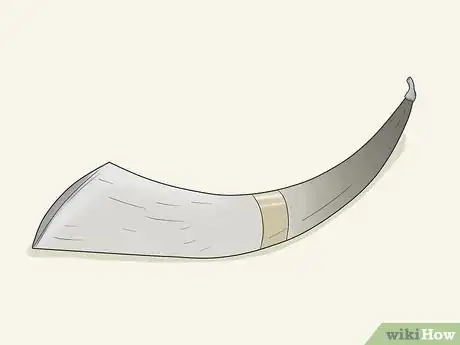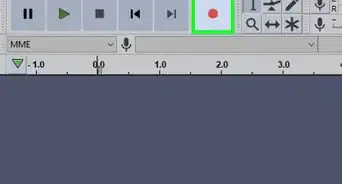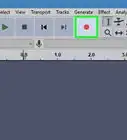This article was co-authored by wikiHow staff writer, Hunter Rising. Hunter Rising is a wikiHow Staff Writer based in Los Angeles. He has more than three years of experience writing for and working with wikiHow. Hunter holds a BFA in Entertainment Design from the University of Wisconsin - Stout and a Minor in English Writing.
There are 7 references cited in this article, which can be found at the bottom of the page.
This article has been viewed 42,124 times.
Learn more...
Viking horns are usually carved out from a cow horn and produce a low note when you blow into them. Playing a Viking horn is similar to playing a trumpet or another brass instrument, but it can take a little practice to get used to. Once you develop your form and can play a note on the horn, you can change the tone and volume of it with some minor adjustments.
Steps
Playing the Horn
-
1Tighten the corners of your lips together to “buzz” them. Keep your lips looser in the center and tight in the corners as if you’re saying the letter M. Vibrate your lips together to make a consistent buzzing noise. Put your hand in front of your mouth and check that you’re blowing out a consistent airstream or else you won’t be able to play the horn very well.[1]
- It may take a few tries before your lips start buzzing.
Tip: Avoid puffing out your cheeks while you’re buzzing your lips since you’ll run out of air faster.
-
2Hold the narrow end of the horn tightly against your lips. Grab the horn by the narrow end, leaving about 1–2 inches (2.5–5.1 cm) between your hand and the tip of the horn. Press the hole at the end of the horn against the middle of your lips so no air can escape out the sides. Position the wide end of the horn so it’s pointing up so the sound of your horn resonates better.[2]
- You can buy a Viking horn online. While they are regularly made with cow horns, you may be able to find horns made from many different animals.
- You can also try putting the Viking horn on the side of your lips if your lips buzz more there.
- Don’t put any part of the horn in your mouth since it won’t play any notes otherwise.
Advertisement -
3Buzz your lips on the horn to play a note. As you’re holding the horn against your lips, start buzzing them as you practiced earlier to produce a sound from the horn. If you don’t hear any noise from your horn, then readjust the horn on your lips and try again. Check that no air escapes out the sides of your mouth or else you won’t get a solid, strong tone. Practice holding the note on your horn as long as you can so you can perfect your form.[3]
- Viking horns can only play a single tone that depends on the size and shape of the horn.
- Longer horns take more air to play a consistent note, so take a deep breath before you start playing.
- Larger horns produce a lower tone while smaller horns are higher pitched.
-
4Click your tongue on the roof of your mouth to play separate notes. After you’ve practiced holding a consistent tone on your horn, click the tip of your tongue against the roof of your mouth just behind your front teeth while you’re playing. Each time you lift your tongue, you’ll block the air for a brief moment and play short, separated notes. Try clicking faster and slower to change the rhythm of the notes you’re playing.[4]
- Practice without your horn by putting your hand in front of your mouth while you practice clicking your tongue. You should be able to feel the breaks in the airflow each time your tongue touches the top of your mouth.
Changing the Horn’s Sound
-
1Purse your lips more to play higher octaves of the same note. While Viking horns only have a single tone, you may be able to play higher pitches by changing your mouth posture. Tighten the corners of your lips more and keep your lips pressed together to limit your airflow more. When you buzz your lips on the horn, the faster air will make your note sound higher pitched. Practice playing your horn while you tighten and loosen your lips to play 2 or 3 different notes.[5]
- Large horns may be more difficult to create a higher pitch than smaller horns.
- You can usually play 1 or 2 different octaves on a Viking horn.
-
2Put your hand in the end of the horn to lower the pitch. Turn your horn so the wide end faces toward your free hand. As you play your note, place the bottom of your palm on the outer rim of the horn’s wide end. Wrap your fingers over the rim so they’re inside the horn. You’ll notice the note change to a lower tone as you put your hand inside the horn and get higher when you remove it.[6]
- Don’t block the end of your horn completely or else it won’t make any noise.
Tip: Try waving your fingers up and down over the end of the horn to make the note waver between high and low pitches.
-
3Get a horn with a mouthpiece if you want to play louder. Some Viking horns have a built-in mouthpiece that makes it easier to form a tight seal. Look for a horn with a metal mouthpiece and play it as you would normally. The mouthpiece will help amplify the horn so it’s louder when you blow into it.[7]
- If you want to add a mouthpiece to your existing horn, you may need to carve the hole on the narrow end to make one fit.












-Step-17-Version-4.webp)




















































